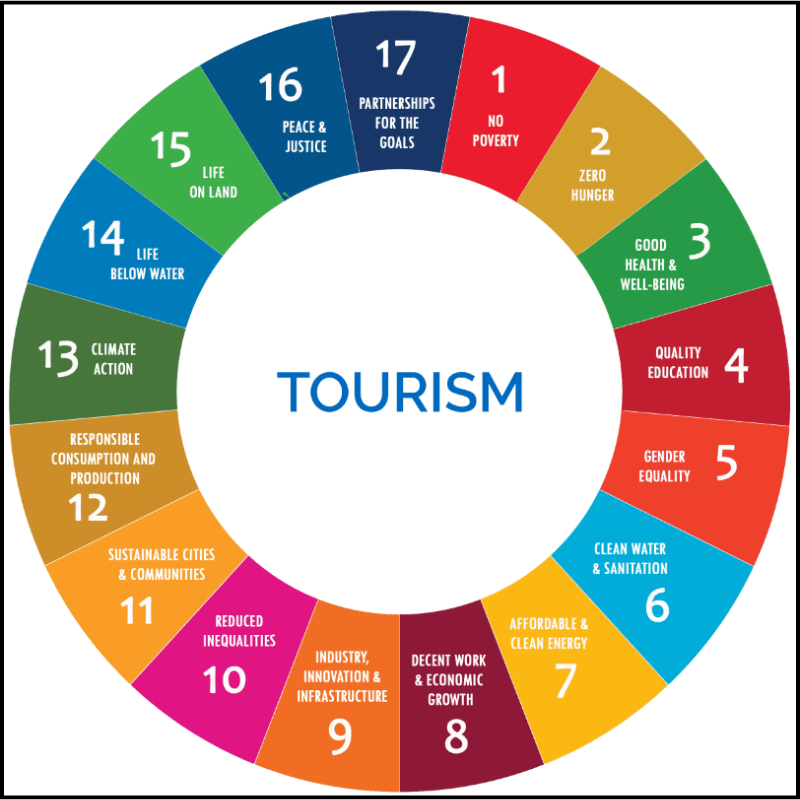
With visitor numbers around the world increasing towards pre-pandemic levels, the issue of overtourism is once again rearing its head. Read here to learn more about the issue.
Numerous major cities are starting to impose bans, fines and taxes to combat tourism-related overcrowding in the cities.
In 2023, the Austrian lakeside village of Hallstatt staged a blockade to highlight the issues faced when places start to feel overrun by tourists.
Hallstatt has just 800 residents but has opened its doors to around 10,000 visitors a day – a population increase of over 1,000%.
Overtourism
Overtourism refers to a scenario where there are too many visitors to a particular destination.
- This excessive influx often results in degradation of the environment, infrastructure strain, diminished quality of life for residents, and a poor visitor experience.
- Overtourism has become a prominent issue in various global destinations, including cities like Venice and Barcelona, or natural sites like Mount Everest and the Galápagos Islands.
- The term ‘overtourism’ is relatively new, having been coined over a decade ago to highlight the spiralling numbers of visitors taking a toll on cities, landmarks and landscapes.
Overtourism is arguably a social phenomenon too.
- In China and India, two of the most populated countries where space is at a premium, crowded places are socially accepted and overtourism concerns are rarely articulated, if at all.
- This suggests that cultural expectations of personal space and expectations of exclusivity differ.
Undertourism
Conversely, ‘undertourism’ is a term applied to less-frequented destinations, particularly in the aftermath of the pandemic.
- Undertourism is a term used to describe areas that receive significantly fewer tourists than their potential suggests they could.
- Unlike overtourism, where the effects are negative due to excessive visitor numbers, undertourism relates to places that suffer from a lack of visitors, which can lead to underdeveloped local economies, lack of investment in infrastructure, and missed opportunities for cultural exchange and environmental conservation.
- The economic, social and environmental benefits of tourism aren’t always passed on to those with plenty of capacity and, while tourist boards are always keen for visitors to visit their lesser-known attractions, it’s a more sustainable and rewarding experience for both residents and visitors.
Causes of Overtourism
Overtourism is typically driven by several factors:
- Affordable Travel Options: Low-cost airlines and budget travel options have made it easier for more people to travel.
- Marketing and Social Media: Locations becoming viral on social media can lead to a sudden spike in visitors wanting to see the same sights.
- Concentration of Tourists in Specific Areas: Many tourists flock to the same, famous attractions rather than exploring less-known areas.
- Increase in Cruise Ship Arrivals: Some cities face days when thousands of passengers disembark, overwhelming local infrastructure and resources.
- Short-term Rental Platforms: Platforms like Airbnb have made it easier for tourists to stay in residential areas, sometimes causing disruptions in these communities.
Impact of overtourism
There are wide-reaching effects, such as climate change.
- Coral reefs, like the Great Barrier Reef and Maya Bay, Thailand, are being degraded by visitors snorkelling, diving and touching the corals, as well as tour boats anchoring in the waters.
- More localised issues are affecting locals, too. Renters are being evicted by landlords in favour of turning properties into holiday lets, and house prices are escalating as a result.
- Skyrocketing prices, excessive queues, crowded beaches, exorbitant noise levels, damage at historical sites and the ramifications to nature, as people overwhelm or stray from official paths, are also negative impacts.
- For visitors also, it can ruin the experience of sightseeing for those trapped in long queues, unable to visit museums, galleries and sites without booking, incurring escalating costs for basics like food, drink and hotels.
- The UN World Tourism Organization (UNWTO) predicts that by 2030, the number of worldwide tourists, which peaked at 1.5 billion in 2019, will reach 1.8 billion, likely leading to greater pressure on already popular spots and more objection from locals.
Protest against overtourism worldwide
Like the residents of Hallsatt, many cities have gone up in protest against the overcrowding and lack of control by authorities worldwide.
- Residents in Venice fought long and hard for a ban on cruise ships, with protest flags often draped from windows.
- In France, the Marseille Provence Cruise Club introduced a flow management system for cruise line passengers in 2020, easing congestion around the popular Notre-Dame-de-la-Garde Basilica.
- In Orkney, Scotland, residents have been up in arms at the number of cruise ships docking on its shores.
Actions taken by cities:
- Barcelona increased its nightly levy in April 2023 — which was originally introduced in 2012 and varies depending on the type of accommodation.
- In Amsterdam, the city council voted to ban cruise ships, while the mayor, commissioned a campaign of discouragement, asking young British men who planned to have a ‘vacation from morals’ to stay away.
- In Rome, sitting at popular sites, such as the Trevi Fountain and the Spanish Steps, has been restricted by the authorities.
- And in Kenya’s Maasai Mara, the Narok County governor has introduced on-the-spot fines for off-roading.
Strategies to Overcome Overtourism

Combating overtourism requires a mix of policy interventions, community involvement, and sustainable tourism practices:
- Regulating Visitor Numbers: Implementing a cap on the number of visitors allowed at sensitive sites each day can help manage the flow and impact of tourists. For example, limiting ticket sales for museums or historical sites.
- Promoting Off-Peak Tourism: Encouraging travel during off-peak seasons can help distribute visitor numbers more evenly throughout the year.
- Developing Alternative Attractions: Authorities and tourism boards can promote less-known sites to divert traffic away from over-visited areas. This approach also helps in the economic development of less popular areas.
- Improving Infrastructure: Enhancing transportation, waste management, and tourist facilities can help destinations cope better with high numbers of visitors.
- Encouraging Responsible Tourism: Educating tourists about the impact of their visits and promoting respectful behaviour towards local culture and environment can mitigate negative effects.
- Local Regulations and Policies: Implementing policies that restrict or regulate accommodations through short-term rental platforms can reduce the pressure on local housing markets and infrastructure.
- Community Engagement: Involving local communities in tourism planning and decision-making ensures that the benefits of tourism are distributed fairly and that community needs are addressed.
- Sustainable Tourism Certifications: Encouraging businesses to adopt sustainable practices and achieve certifications can help raise the overall standard of the tourism industry.
- Technology and Data Usage: Using data analytics to monitor and predict tourist patterns can assist in making proactive adjustments to strategies dealing with tourist inflows.
Why in the news?
On April 25, 2024, Venice, a city in Italy, to control overtourism, introduced an entry fee for visitors who are coming in to visit the city.
- Venice introduced a novel program recently to levy a fee on day-trippers entering the historic Italian city, a pioneering move aimed at alleviating the pressure of mass tourism.
- Despite its status as one of the world’s most loved cities, Venice is grappling with the overwhelming influx of visitors.
Way forward
During the Covid pandemic, tourism was one of the hardest-hit industries according to UNWTO, international tourist arrivals dropped 72% in 2020.
However, traveller numbers have since been rapidly increasing, with double the number of people venturing abroad in the first three months of 2023 than in the same period in 2022.
By applying the strategies, destinations can manage their tourist populations more effectively, ensuring that tourism remains a positive force for the local economy and culture while minimizing environmental and social impacts.
This balanced approach is crucial for the long-term sustainability of tourism worldwide.
Frequently Asked Questions (FAQs)
Q. What is overtourism and why is it a problem?
Ans: When narrow roads become jammed with tourist vehicles, that is overtourism. When wildlife is scared away, when tourists cannot view landmarks because of the crowds, when fragile environments become degraded – these are all signs of overtourism.
Q. What is the meaning of overtourism?
Ans: Overtourism refers to the phenomenon of excessive tourism that creates human, environmental, and social challenges. It is characterized by the concentration of tourism activities and the negative impacts it has on destinations.
Related articles:
- Ecotourism
- Tourism sector
- Cultural tourism in India
- Space tourism
- SASCI Scheme: Boosting tourism in India
-Article by Swathi Satish






Leave a Reply